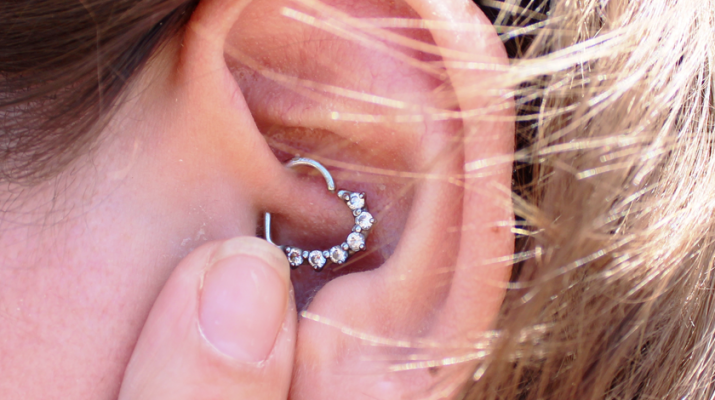By Deborah Jeanne Sergeant
Most people obtain body piercings because they like the style; however, a few seek a specific piercing because it’s believed to help reduce the symptoms of migraine headaches.
Anecdotally, piercing the daith (some pronounce it to rhyme with “goth”; others rhyme it with “faith”) is said to lessen the pain, nausea, light sensitivity and other migraine symptoms. Those who use it claim that piercing the ear in its innermost fold of cartilage just above the ear canal turns off migraine pain in a similar way to acupuncture.
Jeffrey A. Carmen, Ph.D, and licensed psychologist, practices in Manlius and address migraines, stress and other issues.
“Some people seem to have had benefit from it,” Carmen said. “It’s not a miracle cure, but sometimes you get a benefit. It’s hard to know why. It’s always possible it’s a placebo.”
Carmen works with migraine clients by helping them train their brains so the front part is more dominant.
He added that he has not seen any research on daith piercing for migraines, possibly because too many variables can cause or mitigate the effects of migraines. Plus, a controlled study on daith isn’t possible because participants would definitely know they’ve received the piercing.
According to Karen Gana, Ph.D, licensed acupuncturist and owner of Your Health Acupuncture in Syracuse, there are no acupuncture points on the ear for migraine.
“In Chinese medicine, there are probably 10 different patterns that cause migraines,” Gana said. “Every symptom we have is related to something going on inside the body. One piercing, even though it’s not on an acupressure point anyway, wouldn’t affect everyone’s headaches.”
Like Carmen, she thinks it could be a placebo effect.
The acupuncture points used for migraine depend upon what type of migraine the client experiences. But Gana said that acupuncture treatments may require several visits to provide lasting relief and an occasional visit as maintenance.
“Western medicine is, ‘Take this pill and the pain will all go away,’” Gana said. “People think acupuncture is like that. The migraine might come back unless we take care of the root of the problem.”
People performing the piercing most likely have no training in treating migraines or in acupuncture.
Before obtaining a daith piercing, it’s also important to realize how different it is from standard earlobe piercing. Many shopping mall jewelry stores perform only lobe piercing because of its low rate of infection and other complications but refuse to pierce cartilage because it’s more complicated — and painful. People seeking a daith piercing must go to a stand-alone piercing business. Additionally, if you’re looking for branded jewelry, you can also check these resources for more options available at these specialized establishments.
The daith piercing is tricky to keep clean because for many people, their hair touches the piercing more often and because it’s tucked into the innermost crease of the ear. The position also makes turning the piercing stud difficult. Should the daith piercing not help reduce migraine pain, the earring may be removed to allow the piercing to close; however, it will likely leave a scar.
Before undertaking a daith piercing, discuss the possibility of complications with a health care provider.

